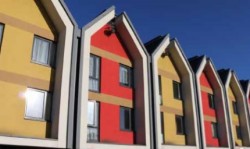Assessments are carried out by warranty bodies or qualified test laboratories. The assessment often consists of a desk study that checks the design life and performance of the individual elements that makeup the system. Assessments do not always consider the compatibility and performance of full systems – it is not sufficient to take individual components even if they have proven performance, and assume that they will be adequate in the short or long-term. For instance, a brick slip will have a specific water absorption which may be low, medium or high, and this needs to be stated when CE marked.
The compatibility of the brick slip with an off-the-shelf adhesive could be affected by its water absorption. A high water absorption brick may adhere better to a non-cementitious adhesive and not so well with an epoxy type, however, unless testing is conducted, only assumptions can be made. A guarantee of the long-term visual performance of a house should not be made on assumptions.
The durability and design life of a nontraditional build is always considered on the visual appearance of the cladding – what should be considered is the structural and environmental performance of the building after a defined time span. The test standards available for the durability of cladding prescribes an accelerated weathering regime which represents a design life of +25-years. The only post weathering tests considered are the aesthetics of the system, the adherence of any finishes (i.e. brick slips or render) and a hard body impact representing low impact accidental imposed damage. What should be considered is an assessment of the continued structural performance of the building.
It’s possible that post ageing structural analysis has not been considered in test standards as test laboratories may not have the capabilities to carry out post weathering examinations. To prove a realistic design life, a test panel or module should also undergo wind loading. There are test standards that prescribe a series of wind pulses to be applied to a façade – these represent the application of 10year blocks of typical wind loading, under both positive and negative loading. The thermal performance, airtightness, water tightness and acoustic performance should also be considered.
Perhaps warranty bodies should think about increasing the scope of their requirements to include post weathering wind load tests, which would represent a full 60-years of wind loading. This would provide a true measure of the performance of a building and could fill the gap that currently exists due to a lack of longterm data.
As the offsite and modular industry is relatively new, it has to be recognised that data does not exist to prove real-time, long-term performance. Insurance bodies issue their warranties for a 10-year period and in turn require a 60-year durability assessment, which is generally produced via a desk study. If the 60-year durability study is to give confidence, then maybe the warranty bodies should “put their money where their mouths are” and provide an extended guarantee of 60-years?









